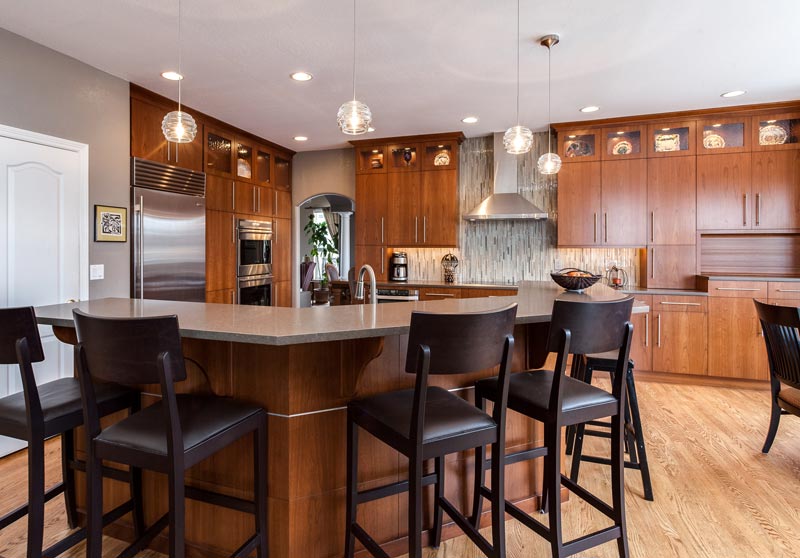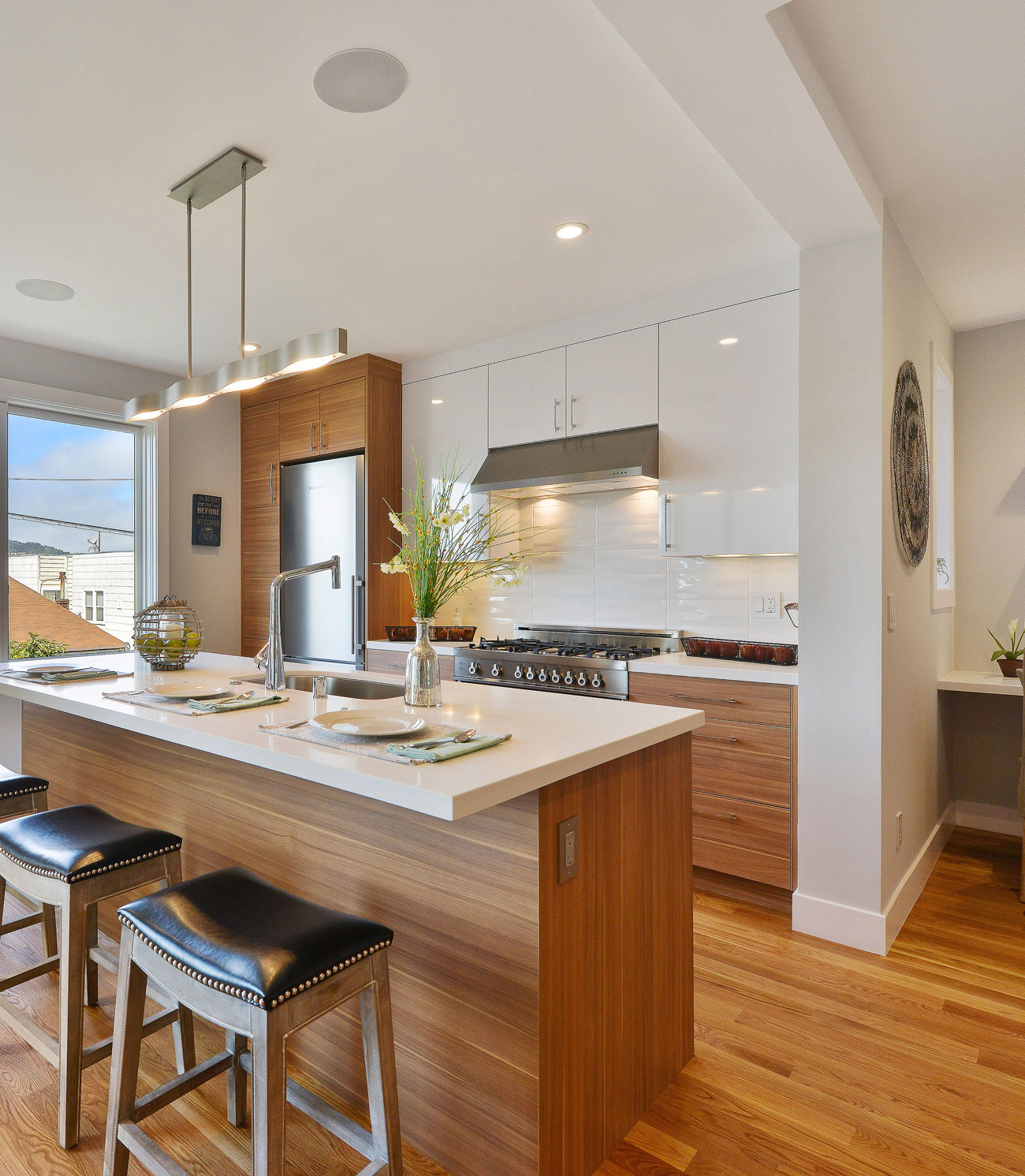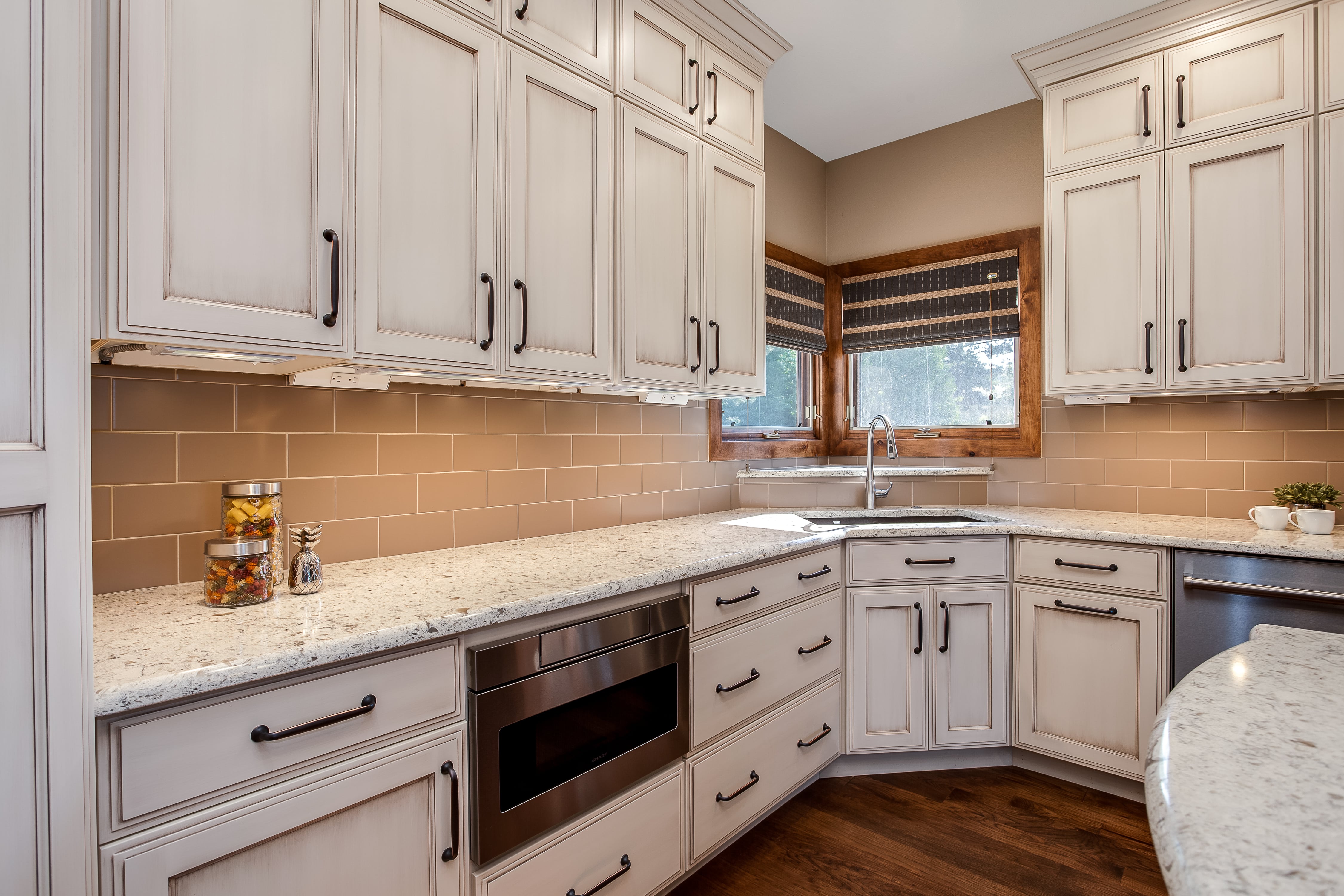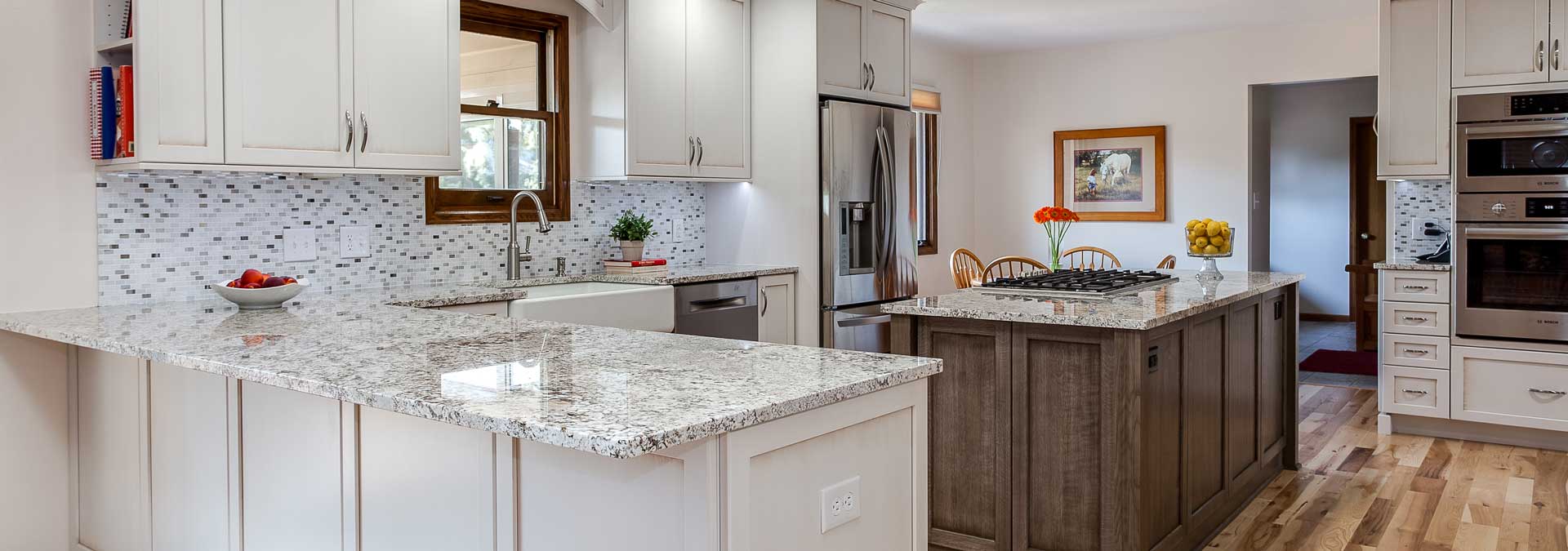
A Guide to Cleaning and Maintaining Your Cabinets
Maintaining your new kitchen not only will increase the useful life of cabinets, appliances, and floor and wall coverings; regular maintenance also will greatly enhance your enjoyment of the space.
Cabinet Care
With proper care, your cabinetry should provide a lifetime of use and satisfaction. Proper care involves attentive cleaning, polishing and careful avoidance of damaging household cleaners. The beauty of wood is in the variation in graining and hue. Because wood is a natural product, it has inherent variation. This variation includes many natural characteristics as a result of tree growth patterns, as well as differences in wood color and grain due to variations in forest growing conditions. We apply and then hand wipe our stains to bring out the natural character and sheen of the wood.
Upon Installation
Wipe the cabinets clean with a soft, damp cloth and dry immediately with another clean, soft cloth. Always wipe in the direction of the wood grain. Apply a thin coat of high-quality polish. Choose a polish that does not contain silicone or wax, and follow the manufacturer’s directions for application. A high-quality polish will aid in protection from minor scratching, staining, and excessive moisture.
Basic Cabinet Cleaning
Grease and grime buildup can damage cabinets and destroy the look and feel of a new kitchen. To remove buildup wipe down cabinets using a soft cloth dampened with warm water and do so at least once every two weeks or more often depending on the amount of activity that takes place in the kitchen. If water alone does not clean cabinets completely, mix a little mild dishwasher soap with the water. Wipe down wood cabinets in the direction of the grain. Use a soft cloth to remove any residual moisture that may be left on the cabinets.
If routine cleaning does not remove stains or built-up grime, create a paste by mixing baking soda with water. Place the paste on a sponge and scrub the stain until it disappears. Rinse with water and dry with a soft cloth. A mix of vinegar and water is another option for removing sticky grime or film from kitchen cabinets.
The following products and ingredients can damage cabinets so avoid using them or any product that contains them:
- Petroleum-based products
- Solvents
- Bleach
- Strong detergents and soaps
- Nail polish remover
- Paint thinners
- Plastic brushes
- Steel wool
- Scoring Pad
- Ammonia
Repairing Nicks and Scratches
We typically provide a touch-up kit to our clients so they can maintain the beauty of their kitchen. If you have recently updated your kitchen and did not receive a touch-up kit, ask the showroom to obtain one on your behalf.
Wipe Spills Promptly
Many substances become difficult to remove and may stain or cause other damage upon prolonged contact. If a spill occurs, wipe it promptly with a damp cloth or sponge and dry the surface immediately. Use a blotting action rather than a wiping action to remove the substance
Avoid Excessive Moisture
This is one of the worst enemies of any finish. Cabinetry near the sink and dishwasher and baseboards are most susceptible. Dry off any areas immediately where water has spilled. Avoid draping dish towels or other wet items over doors or placing coffee makers where steam vents directly onto cabinet surfaces.
Avoid Temperature And Humidity Extremes
Extremes in temperature and humidity can cause wood to expand and contract, swell or warp, and dry out– possibly damaging the finish of your cabinetry. It is important to control the temperature and humidity in your home all year long. You should allow minor warping to go through one heating cycle before considering replacement.
Avoid Light Damage
Direct exposure to Colorado sunlight can have a damaging effect on your cabinets especially those made from natural wood. Painted wood cabinets and laminated or Thermofoil surfaces also are susceptible to fading from prolonged exposure to direct sunlight. Use window coverings to help reduce or eliminate damage caused by exposure to direct sunlight.
Avoid Exposure To Harsh Cleaners
Harsh cleaners can damage the finish of your cabinetry. Avoid cleaners containing ammonia, bleach, citric acid (including orange and lemon oil) and organic solvents.
Avoid Exposure To Waxes
Most common self-polishing waxes can damage your finish. Take care to use only high-quality cream furniture polishes available from high-end furniture or paint stores.
Guard Against Scratching And Abrasion
Clean with a soft, damp cloth when necessary. Avoid using scouring pads and abrasive cleaners as they may dull fine finishes.
Guard Against Plastic And Rubber
Use felt or cloth under plastic or rubber objects as their ingredients may react with wood countertops.
- Avoid Aggressive Acids
- Avoid products containing aggressive acids or abrasives as they may cause damage to laminate finishes (Lime-AWay, Soft Scrub, Tilex, etc.).
- Avoid Chips And Scratches
- Avoid abrasive cleansers and cleaning tools. Some “stiff” paper towels may leave tiny scratches that dull the surface.
Always use a soft cloth when cleaning laminate surfaces. Never use a laminate countertop as a cutting surface. Use a chopping block when cutting to avoid chipping and scratching. Fine scratches may be covered with a light spray furniture polish.

Maintenance Tips For Laminate Products
With proper care, our laminate products will last a lifetime. Generally, a damp sponge is all you need for the everyday maintenance of laminate surfaces.
Basic Cleaning
Use a soft cloth to wash the surface with warm water and mild dishwashing detergent. Rinse with warm water and dry with a soft cloth. Use an all-purpose cleaner or bathroom cleanser to remove spots and stains.
Stubborn Spots and Stains
Mix baking soda and water to create a paste. Use a soft bristle brush to gently rub the spot in a circular motion. The paste will be slightly abrasive, so work carefully, pressing very lightly. Rinse and dry with a soft cloth. Repeat the process as long as you’re making progress. If the stain remains, use undiluted household bleach; the label should read 5% solution of sodium hypochlorite. Take special care to protect your eyes, skin, and clothing. Apply the bleach using a wet sponge or paper towel, place it on the stain and let sit for no longer than one and a half minutes. Rinse repeatedly with warm water and dry with a soft cloth.
Tips For Maple Chopping Block
Basic Cleaning
Our top-quality Butcher Block is intended to be used as a true cutting surface. Clean it like you would any cutting surface, taking care not to allow water to remain on the surface for any prolonged length of time.
Periodically Reseal The Surface
Occasionally use mineral or vegetable oil to reseal and help preserve your block. Reseal only the area on which you frequently cut. Upon years of heavy use, it may become necessary to refinish the block. Sand off the finish and reseal using either a mineral or vegetable oil or with “Good Stuff” Urethane Gel clear protective finish.

How Humidity and Temperature Affect Your Cabinetry in Colorado
With proper care, Crystal cabinetry will provide a lifetime of use and satisfaction. Proper care includes providing a wood-friendly environment. Many of the internal environmental issues that affect human comfort also contribute to a wood healthy environment. Specifically, controlled temperature and humidity with minimal changes from day to day and season to season will ensure your comfort and they will ensure the stability and life of your wood cabinetry.
Moisture
• Repeated short-term exposure to excessive moisture such as splashing of surfaces from a sink or even a single longer term event such as flooding WILL result in irreversible damage to wood cabinetry.
• Steam, as from cooktops, crock pots and improperly sealed dishwasher doors, can cause problems as well.
• Moisture should be wiped from surfaces immediately to minimize damage.• If the wood has a chance to absorb excess moisture, efforts should be made to dry out the wood including substrates
immediately.
• Avoid direct high heat and instead, use fans and dehumidifiers and moisture absorbing cloth and compounds.
• Immediate attention reduces the amount of damage and also reduces the likelihood of mold and mildew.
Humidity
• Wood expands as humidity increases and shrinks as humidity decreases.
• Unfinished (exposed) wood will exhibit the most dramatic changes
• Even finished wood will change with long-term changes in humidity.
• Finishes and other coatings such as laminate or foil temper humidity swings by slowing the transfer of moisture.
• They do not stop it entirely.
• Solid wood will dimensionally change more across the grain than with grain.
• Plywood, particleboard, and fiberboard are more dimensionally stable.
• Particleboard and fiberboard, exposed to water directly, will expand in thickness quickly and dramatically.
• As wood expands (swells) and contracts with changes in humidity, the finish at joints will crack.
• This cracking is universal but is much more evident on light colored paint than on stains or dark paints.
• Regardless, this is the nature of product made from wood and not a reason for replacement.
• Where humidity exposure is uneven, pieces may warp, cup or bow.
• Most often, if the humidity level is returned to a normal level and maintained for a period of time, these issues will disappear.
• Extremely dry conditions can result in wood parts splitting and/or cracking in addition to shrinkage as described above.
• The optimal humidity level is 35% to 50% relative humidity.
• Extreme conditions (lower than 20% or higher than 80%) especially need to be avoided.
Humidity Continued (Dryness) While most focus is on too wet (damp) or too humid conditions, too dry conditions can be equally damaging to cabinetry.
• Extreme dry conditions can lead to cracking in solid wood components.
• Under dry conditions, the insert panels in panel doors will shrink and the panel edges will be exposed.
• The exposed, unfinished panel edges will not match the finished surface of the rest of the panel and door.
• This is not a reason for a replacement but is instead an indication that humidity levels are too low and need to be remedied.
Temperature
• Temperature variation can cause some of the same problems as humidity variation and the two are often interrelated.
• Temperature increases cause materials to expand.
• Temperature decreases cause materials to contract or shrink.
• Sudden temperature changes cause more dramatic material changes.
• More likely to lead to cracking, and splitting in solid wood.
• More likely to lead to warping, cupping and bowing in any wood components.
Remediation
• Use dehumidifiers and/or air conditioners in summer to control excess humidity.
• Use a humidifier to keep the air from becoming too dry in winter.
• Maintain climate control during the offseason of vacation homes to reduce the risk of damage.
• Prior to installation of new cabinets, acclimate the cabinetry by moving it into the room it will be in when done.
• This should be done well in advance of the installation.
• If this is not possible, use an adjoining room of similar climate conditions.
• Do not store in a garage, basement or other unheated or unconditioned space prior to installation.
• Temperature and humidity are also affected by:
• Proper outside drainage
• Adequate insulation
• Properly installed vapor barriers
• Adequate and proper ventilation and air exchange.
Remember: Properly controlling temperature and humidity inside the house is healthier for the inhabitants as well as for the cabinetry and furniture within.
These basic maintenance tips help our clients enjoy their new kitchens for many years. Do you have a kitchen maintenance question? Give us a call or visit one of our showrooms, our kitchen experts are happy to help.




















